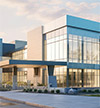Explosive Growth of Life Sciences Sector Comes with Challenges
Although opportunities abound, companies in the life sciences sector are also facing numerous challenges — from accessing skilled labor to deciding whether to build out or retrofit existing space.
Q3 2022

Since around 2010, thanks to a surge in new products and technology, as well as an influx of capital from both public and private investors, the life sciences sector has seen significant growth. The last two years have seen tremendous expansion with $70 billion of private equity (PE) capital and public National Institutes of Health (NIH) funding pouring into life sciences-related companies in North America in 2020 — and a record $78 billion in 2021. Building off the successful use of mRNA technology to produce effective and commercially viable vaccines, the life sciences industry is rushing to apply the lessons learned to other conditions like cystic fibrosis, cancer, and HIV.
And while the life sciences industry is not immune to the volatility the public markets have experienced in 2022, we expect the life sciences industry will weather the challenges of 2022 and emerge with continued success — safely bringing novel treatments, devices, and cures to the population at scale.
From a commercial real estate and development perspective, the most exciting part is that demand is going to continue, especially in markets that are mature, like Boston, San Francisco, and New York City. At the same time, new markets are quickly gaining traction and attracting new investments as some tenants are finding the established markets too pricey or lacking their required space.
Accessing Skilled Labor
This rapid expansion and high demand have led to some complex calculus when determining where to locate; whether to develop new or lease (or potentially refit) existing space. Each option presents both challenges and opportunities for the developer and/or tenant.
We expect the life sciences industry will weather the challenges of 2022 and emerge with continued success. In mature markets, access to a robust labor force is most important for occupiers. Leading universities are the source of this labor for both incubators and more mature companies, giving them access and proximity to readily available skilled employees. A well-educated labor pool is a key ingredient for growth and is often one of the first requirements for tenants looking at a market. The old chant of “location, location, location” can easily be replaced by “talent, talent, talent” for the life sciences sector.
Occasionally that ready pipeline of skilled labor can’t offset the higher costs, low availability of space, and fierce competition for talent found in the mature markets. It can often be hard for an emerging life sciences company to compete on that playing field with consumer-facing brands whose products are in your medicine cabinet — or in your arm.
Some of these companies are now looking to tertiary markets to improve cost and, in turn, draw the workforce to them — or incentivizing postsecondary institutions to beef up their life sciences programs to meet the growing need. This is, of course, encouraged and enabled by eager economic development corporations. Salt Lake City, Denver, Austin, and Dallas are in this category, putting a greater focus on attracting life sciences sector companies, with assurances the talent will be there when they need it.
Receiving Funding
Another often overlooked factor in location selection is funding. Mature markets have a significant advantage over tertiary markets in terms of dollars invested in the sector – and the more funding the market receives, the more capital available to expand the sector.
One indicator for a market moving up in the ranks is when it starts receiving more venture capital (VC) dollars to fund research in the markets. The NIH funding increases in some tertiary markets, but the lion’s share goes to the same top-tier institutions year after year. Once we see that shift starting to move into tertiary markets, then we know more research will be funded, more companies can enter later-stage development, and the pressure will be on for more real estate development. Right now, the top 10 markets that receive NIH funding are those more mature markets.
The money does a lot: It funds research, which means hiring staff, hopefully opening an office, or building out laboratory space. It can also lead to mistakes, as brilliant scientists and researchers are tasked with complex business decisions that are outside their area of expertise — and in secondary and tertiary markets, this can be compounded by developers and landlords inexperienced with the life sciences sector and its unique needs.
A well-educated labor pool is a key ingredient for growth and is often one of the first requirements for tenants looking at a market. Imagine the Ivy League professor receiving VC funding and needing to ramp up clinical manufacturing but with no understanding of development, site selection, real estate, or project development. This is a frequent scenario playing out in real time as medical advances continue at a breakneck pace.
An Ongoing Process
The most common pitfall when emerging companies start an expansion process is thinking of their potential space as a static financial decision — “one and done.” Instead, life sciences companies should think of their real estate as a part of the scientific (and commercial) program — an ongoing and mapped out process that will support their research, development, and/or commercialization in a sustainable and effective way. Tenants should be asking, “What is the business case” and “How should I prepare to hit my operational goals?” From that basic starting point, and with the right advisors, the rest (from location selection and ceiling height to specialty plumbing and electrical) can start to fall into place. It may seem elementary, but it is something the life sciences sector has struggled to do.
Of course, all of this is made more challenging by the inevitable pressure to “get to market” and start providing a return for investors. All industries have investor pressure; however, human therapeutics that require FDA approval are particularly challenging because of the lead time to discover, develop, and commercialize an approved product.
That pressure can lead to shortcuts in the project development that can end up costing time and money over the course of a project. That Ivy League professor with cash-in-hand might be tempted to look at converted space to meet the growing company’s needs, but that comes with its own set of challenges versus a ground-up development.
Large pharmaceutical and biotechnology companies have enough existing product revenue and a deep enough future product pipeline to purpose-build an owned facility for manufacturing and, oftentimes, R&D as well. However, younger, early-stage, pre-revenue companies do not have the luxury of this option. Due to size of facility, time to design/construct/commission, and due to financial drivers, these younger companies nearly always lease (vs. own) space.
The most common pitfall when emerging companies start an expansion process is thinking of their potential space as a static financial decision — “one and done.” Given the historically low availability of speculatively built life science space, the competition to quickly land a prime space (that it will programmatically and physically meet the needs of the science and business plan) immediately after closing Series A funding must feel, to both university professor and seasoned CEO, like balancing a chair on their chin while spinning plates on sticks while riding a unicycle!
Prioritizing Tradeoffs
Developers have taken note of the low, speculatively built, life sciences supply in the past few years (fueled, in part, by the fact that activity in office real estate largely ground to a halt in mid-2020). Conversions — large and small scale — are popping up all over the country. But these aren’t as simple or straightforward as they might seem. Typically, the biggest advantage of a conversion space is speed to market. However, it is unlikely that it will “check all the boxes” for every type of life sciences tenant. The compromise is availability over functionality. This is also why it is so important for occupiers to incorporate the real estate activity into the business and science planning — because during the search process, the decision-making team will likely be faced with prioritizing tradeoffs.
For developers or owner/occupiers setting out on this path, they should be aware that, in many cases, the interior space will need to be completely redesigned and often the operating mechanics of the building will need to be completely replaced (even if the “old stuff” was brand new). This can increase the risk profile of the redevelopment, especially if they’re building the space for a speculative, non-credit occupier. Ultimately though, it should provide tenants occupancy faster than a new-build, particularly if a new-build requires entitlement changes or significant site work. That said, even if it’s a longer process, it’s usually easier to start from ground up in most cases.
Project Announcements
BioStem Technologies Plans Boca Raton, Florida, Headquarters Operations
12/06/2025
AstraZeneca Expands Frederick-Gaithersburg Maryland, Manufacturing Operations
11/29/2025
South Korean-Based Nature Cell Plans Baltimore City, Maryland, Production Operations
11/19/2025
Regeneron Pharmaceuticals Plans Saratoga Springs, New York, Manufacturing Operations
11/17/2025
AndHealth Expands Columbus, Ohio, Headqurters Operations
11/14/2025
Taiwan-Based Bora Pharmaceuticals Expands Baltimore, Maryland Operations
11/13/2025
Most Read
-
The Workforce Bottleneck in America’s Manufacturing Revival
Q4 2025
-
Rethinking Local Governments Through Consolidation and Choice
Q3 2025
-
First Person: Filter King’s Expansion Playbook
Q3 2025
-
Lead with Facts, Land the Deal
Q3 2025
-
How Canada Stays Competitive
Q3 2025
-
Investors Seek Shelter in Food-Focused Real Estate
Q3 2025
-
America’s Aerospace Reboot
Q3 2025
